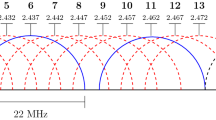Abstract
Heterogeneity of connection technologies and nodes mobility open new challenges in home networks control strategies. Moreover, user’s needs are changing towards applications requiring high transmission speeds such as 3D gaming, enhanced interactivity and high definition video. Each of those applications puts several constraints on the network capabilities to guarantee requirements on the Quality of Service. In this paper we introduce an innovative concept based on fast load balancing algorithm operating on top of a convergence layer, in order to rapidly react to network changes and contemporaneously to satisfy strict application demands. We formulated the load balancing problem as a Multi-Commodity Flow and resolved it with a column generation approach using Lagrangian Relaxation and Dijkstra algorithm. The load balancing problem computational complexity is decreased with respect to state of the art load balancing solutions based on linear programming techniques. Proof of concept simulation results are reported.





























Similar content being viewed by others
References
Javaid, U., Meddour, D. E., & Rasheed, T. M. (2006). Towards universal convergence in heterogeneous wireless networks using ad-hoc connectivity. In International symposium on wireless personal multimedia communications, San Diego.
Wood, L., Eddy, W. M., Ivancic, W., McKim, J., & Jackson, C. (2007). Saratoga: a delay-tolerant networking convergence layer with efficient link utilization. In Third international workshop on satellite and space communications.
Yamada, K., Furumura, T., Kimura, K., Kaneyama, T., Yoshida, K., Kojima, M., Mineno, H., & Mizuno, T. (2007). Dual communication system using wired and wireless in home-network. In Knowledge-based intelligent information and engineering systems, pp. 469–476. ISBN 978-3-540-74828-1. doi:10.1007/978-3-540-74829-8_58.
Bruni, C., Delli Priscoli, F., Koch, G., & Marchetti, I. (2006). An innovative approach to the formulation of connection admission control problem. World Academy of Science, Engineering and Technology, 18. ISSN 1307-6884.
Meyer, T., Langendorfer, P., Suraci, V., Nowak, S., & Bahr, M. (2009). An inter-MAC architecture for heterogeneous gigabit home networks. In Multi-gigabit wireless systems—MGWS, part of PIMRC, Tokyo.
Ford, L. R. Jr., & Fulkerson, D. R. (1958). A suggested computation for maximal multi-commodity network flows. Management Science, 5, 97–101.
Dijkstra, E. W. (1959). A note on two problems in conneximon with graphs. Numerische Mathematik. doi:10.1007/BF01386390.
Fox, B. L., & Landi, D. M. (1970). Searching for the multiplier in one-constraint optimization problems. Operations Research, 18(2), 253–262.
Ferguson, T. S. (2013). Linear programming a concise programming. http://www.usna.edu/Users/weapsys/avramov/Compressed%20sensing%20tutorial/LP.pdf.
Pfetsch, M. (2013). Multicommodity flows and column generation. Lecture notes http://www.zib.de/borndoerfer/Homepage/Documents/IPOV-WS06-MultiCommodityFlow.pdf.
Carlyle, M., Royset, J. O., & Wood, R. K. (2008). Lagrangian relaxation and enumeration for solving constrainedshortest-path problems. Networks, 52(4). doi:10.1002/net.v52:4.
OPNET Modeler 11.5A (2013). OPNET Technologies, Inc. 7255 Woodmont Ave., Bethesda, MD 20814, USA. www.opnet.com.
Terziyan, V., Zhovtobryukh, D., & Katasonov, A. (2009). Proactive future Internet: smart semantic middleware for overlay architecture. In Fifth international conference on networking and services.
Van Der Meer, S., Strassner, J., & Phelan, P. (2009). The design of a novel autonomic management methodology and architecture for next generation and future Internet systems. In Sixth IEEE conference and workshops on engineering of autonomic and autonomous systems.
Galis, A., Abramowicz, H., & Brenner, M. (2009). Management and service-aware networking architectures (MANA) for future Internet. Position Paper.
Delli Priscoli, F. (2010). A fully cognitive approach for future Internet. MDPI - Open Access Publishing, 2, 16–29. Special issue on “Future Network Architectures” of “Future Internet”.
Zhong, J., Hu, R., & Zhu, X. (2010). A novel load-balancing algorithm for QoS provisionings over 802.11s wireless mesh networks. In Wireless communications networking and mobile computing (WiCOM), 6th international conference, September 2010, Chengdu, China.
Wu, X., & Nie, G. (2009). Design and simulation of an enhanced handover scheme in heterogeneous mobile IPv6 networks. In Asia-pacific conference on information processing (APCIP) 2009, 18th–19th July 2009, Shenzhen, China.
Meddour, D. E., Kortebi, A., & Boutaba, R. (2010). Mesh-based broadband home network solution: setup and experiments. In IEEE international conference on communications (ICC) 2010, 23rd–27th May 2010, Cape Town, South Africa.
Sahaly, S., & Christin, P. (2009). Inter-MAC forwarding and load balancing per flow. In IEEE 20th international symposium on personal, indoor and mobile radio communications (PIMRC) 2009, 13th–16th September 2009, Tokyo, Japan.
He, X., Tang, H., Zhu, M., & Chu, Q. (2009). Flow-level based adaptive load balancing in MPLS networks. In Fourth international conference on communications and networking in China (ChinaCOM) 2009, 26th–28th August 2009, Xi’an, China.
Lawrence, V., Zervos, N., Zahariadis, T., & Meliones, A. (2010). Digital gateways for multimedia home networks. Telecommunications Systems, 23(3–4), 335–349. ISSN:1018-4864, doi:10.1023/A:1024489827061.
Karetsos, G. T., Tragos, E. Z., & Tsiropoulos, G. I. A holistic approach to minimizing handover latency in heterogeneous wireless networking environments. Telecommunications Systems. ISSN: 1018-4864, doi:10.1007/s11235-011-9498-0.
Develder, C., Lambert, P., et al. Delivering scalable video with QoS to the home. Telecommunications Systems. ISSN: 1018-4864, doi:10.1007/s11235-010-9358-3.
UPnP-QoS Architecture:3 (2008). Web site http://www.upnp.org/specs/qos/UPnP-qos-Architecture-v3.pdf. Accessed on 15th of June, 2011.
Acknowledgements
The research leading to these results has received funding from the European Community’s Seventh Framework Programme FP7/2007-2013 under grant agreement n∘213311 also referred as OMEGA.
Author information
Authors and Affiliations
Corresponding author
Rights and permissions
About this article
Cite this article
Macone, D., Oddi, G., Palo, A. et al. A dynamic load balancing algorithm for Quality of Service and mobility management in next generation home networks. Telecommun Syst 53, 265–283 (2013). https://doi.org/10.1007/s11235-013-9697-y
Published:
Issue Date:
DOI: https://doi.org/10.1007/s11235-013-9697-y




